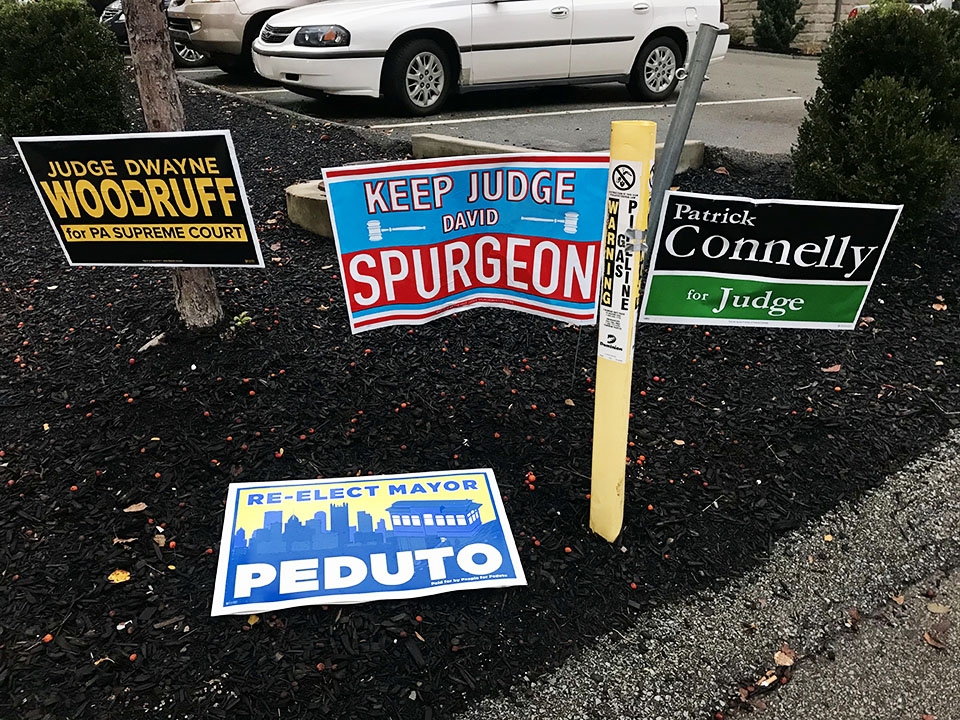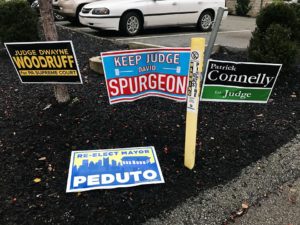
Campaign signs stand in the parking lot of Epiphany Church, one of Pittsburgh’s many polling places, on Nov. 7. A variety of state and local positions were on the ballot throughout the country. Woodruff (D) was defeated in his attempt to unseat Sallie Mundy (R) on the PA Supreme Court. Spurgeon (D) and Connelly (D/R) both were elected as judges to the Allegheny County Common Pleas Court. Tuesday.

Campaign signs stand in the parking lot of Epiphany Church, one of Pittsburgh’s many polling places, on Nov. 7. A variety of state and local positions were on the ballot throughout the country. Woodruff (D) was defeated in his attempt to unseat Sallie Mundy (R) on the PA Supreme Court. Spurgeon (D) and Connelly (D/R) both were elected as judges to the Allegheny County Common Pleas Court. Tuesday.
Raymond Arke | News Editor
11/09/17
A blue tide washed over the American electorate Nov. 7, as Democrats won resoundingly in many local and state elections across the nation. However, statewide results in Pennsylvania showed more mixed results for both parties.
According to the Pennsylvania Department of State unofficial election returns, with 99 percent of precincts reporting, Republican state Supreme Court Justice Sallie Mundy held on to her seat defeating Democratic challenger, former Steelers player and Duquesne Law grad Dwayne Woodruff.
Pennsylvania Democrats had more success in the Superior Court elections. Unofficial results had three Democrats, Maria McLaughlin (14.09 percent), Carolyn Nichols (12.78 percent) and Deborah Kunselman (13.61 percent) elected to the bench. They were joined by Republican Mary Murray who garnered 12.01 percent of the vote.
The parties split the two slots for Commonwealth Court. Unofficial returns reported that Christine Fizzano Cannon, a Republican, won 25.83 percent and Ellen Ceisler, a Democrat, captured 25.63 percent.
The statewide ballot measure, which would allow the Pennsylvania legislature to possibly reduce or eliminate the property tax, passed with a comfortable 53.98 percent of voters approving.
Philadelphia saw the election of Larry Krasner to the position of district attorney. Krasner, a civil rights attorney, has sued the police multiple times before and is opposed to the death penalty. He ran on the platform of introducing numerous justice system reforms and was opposed by the local police union, according to the Associated Press.
More locally, in Allegheny County, Mayor Bill Peduto (D) won his unopposed re-election in a landslide with 96 percent of the vote. The Pittsburgh referendum on allowing city employees to take part-time paid positions coaching in the public school system or teaching at public universities, passed with 73 percent support, according to WESA, Pittsburgh’s NPR station.
Turnout was low in Allegheny County with reports showing only 23.4 percent of registered voters went to the polls. Turnout in Pittsburgh Ward One, District One, where Duquesne is located, was particularly dismal. Reports showed that only 116 ballots were cast, making up only 3 percent of all registered voters.
The biggest stories of the evening were in other states, as results in Virginia were especially notable.
Ralph Northam, the Democratic nominee for governor, won a commanding victory over his Republican challenger, Ed Gillespie. Northam exceeded expectations in what many thought was supposed to be a close race, capturing a nine point victory.
Even more surprising was the Democratic swing in the Virginia House of Delegates, which has been controlled by Republicans since 2000. Democrats picked up at least 15 seats, with several likely to go into recounts. This could mean a 50-50 split or slight Democratic majority depending on the remaining close races. Jessica Post, the executive director for the Democratic Legislative Campaign Committee, described the gain of seats in Virginia in a tweet as “the biggest Democratic pick-up since 1899.”
Several individual stories in Virginia were notable. Danica Roem became the first openly transgender person elected to a U.S. state house, defeating a Republican incumbent who called himself Virginia’s “chief homophobe,” according to the Washington Post. Virginia also saw the upset victory of Lee Carter, a member of the Democratic Socialists of America, to the House of Delegates beating a high-ranking member of Republican leadership.
Elsewhere across the country, Democrats were victorious in New Jersey’s governor’s race where Phil Murphy won and in Maine, which became the first state to expand Medicare through a ballot referendum. Additionally, Democratic New York City Mayor Bill de Blasio was re-elected in a landslide.
Dave Weigel, a national political correspondent for the Washington Post, credits the wave of Democratic victories to increased turnout.
“Democrats throughout the Obama era, and before, could not figure out how to get voters to show up except for presidential elections … there was an awakening after Trump won,” he said.
Weigel said the post-2016 election creation of new groups like Indivisible, which focus on boosting turnout and recruiting Democratic candidates, helped bring about a “change of attitude” among Democratic voters.
Looking towards the national midterm elections in 2018, Weigel sees an invigorated liberal voting population.
“For the Democrats, their base is more motivated, more active,” he said.
Kyle Kondik, managing editor of the Sabato’s Crystal Ball, a renowned weekly online newsletter based out of the University of Virginia, cited the vast discontent with the president as reason for the Democratic gains.
“Tuesday’s results, particularly in Virginia, were driven by President Trump’s terrible approval numbers driving turnout amongst fired-up Democrats,” he said.
He also added that this is often a common scenario and that it’s still too early to tell what 2018 may bring.
“Historically, this is what sometimes happens to the president’s party in off-year elections: The other side makes gains, particularly if the president is unpopular,” Kondik said. “If this environment is repeated next year the Democrats should be able to make substantial gains, but of course it’s a long way away and a lot can change.”




